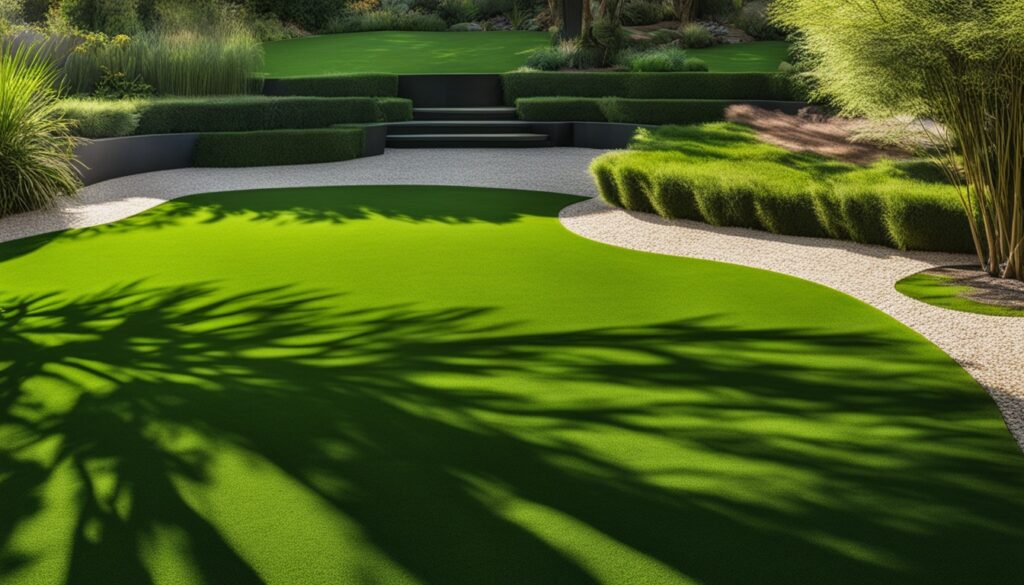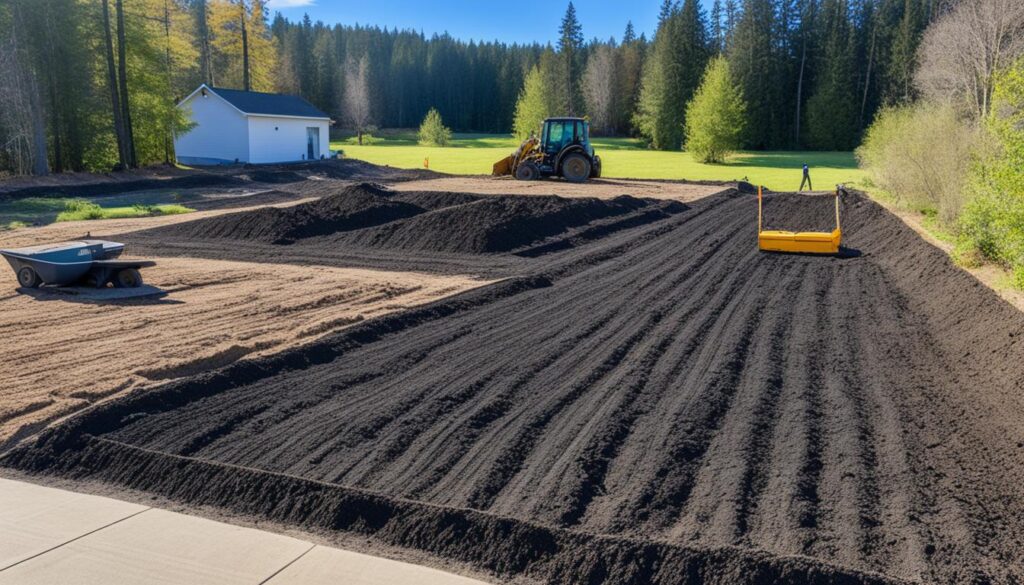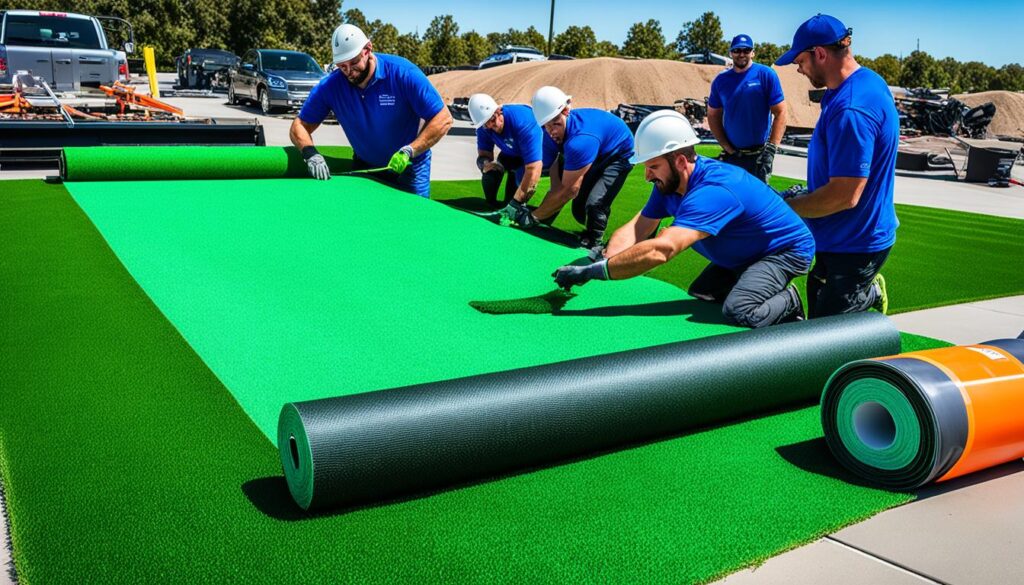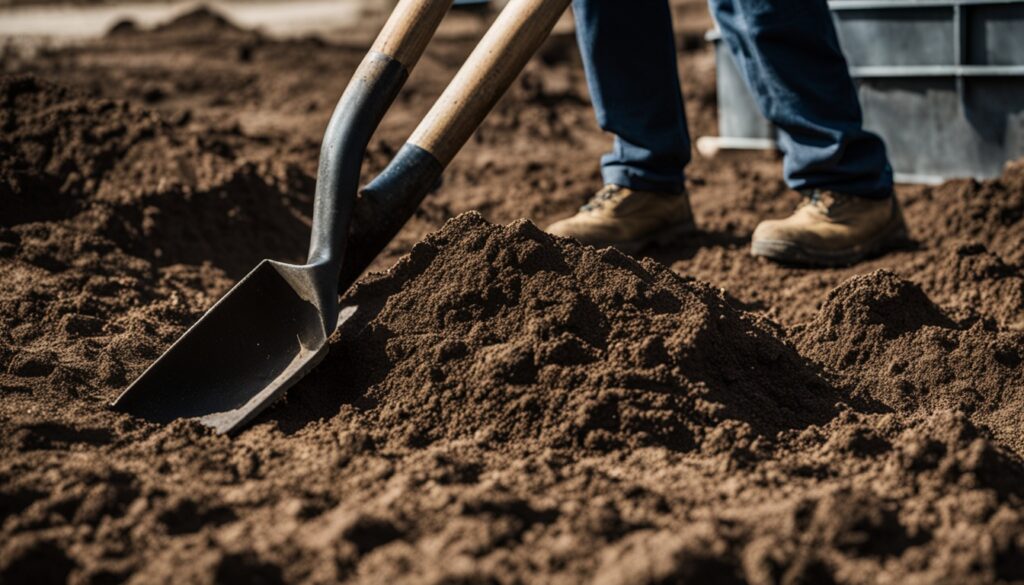Many homeowners want a green lawn without the work of mowing and watering. That’s why they choose artificial grass. It looks and feels like real grass but doesn’t need much care. This guide will cover the good things about it, the different kinds, how to put it in, keeping it up, and its effect on the planet. It will help you decide if it’s right for your yard.
Introduction to Artificial Grass
Artificial grass, also known as synthetic turf, is a popular choice over traditional grass. It needs little care, looks great all year, and lasts a long time. People use it in homes, businesses, and for sports. It makes low-maintenance lawns that can handle a lot of people and weather.
Benefits of Artificial Grass
Artificial grass is easy to take care of. You don’t need to mow, water, or fertilize it like real grass. This saves a lot of time. Plus, it lasts a long time and can handle tough weather without getting damaged.
Types of Artificial Grass
There are many kinds of artificial grass, each with its own perks. Some main things that make them different include:
- Pile height: You can choose from short, dense blades to longer, flowing ones. This affects how it looks and feels.
- Pile weight: The yarn’s weight tells you about its quality and how thick it is.
- Blade shape: The shape of the blades changes the texture and how it reflects light.
- Backing material: The backing can be made of polyurethane (PU) or latex. These affect how well it resists moisture and lasts.
- Drainage capabilities: Some artificial grass has special holes to help water drain away quickly.
People and designers can pick from many artificial grass types for their needs and likes. This way, they get a beautiful, easy-to-care-for lawn that makes their place look better.

Preparing for Artificial Grass Installation
Getting ready for artificial grass installation is key. First, check the site and test the soil’s drainage. Make sure the area is clear of obstacles or gophers that could harm the turf. Fixing drainage and leveling the ground are important steps.
Start by checking the area where the artificial grass will go. Measure the space, look for slopes or uneven spots, and see if there’s any plants or trash. Getting the site ready right helps the turf last longer and work better.
Then, look into the soil testing and drainage considerations. Good drainage is key for artificial grass. If water tends to collect, you might need a drainage system or soil that lets water through. This stops water from pooling or draining badly, which can hurt the turf.
- Conduct a thorough site assessment to identify any potential obstacles or uneven surfaces
- Test the soil’s drainage capacity and address any issues to ensure proper water flow
- Remove any existing vegetation, debris, or obstacles that could interfere with the artificial grass installation
- Create a smooth, level base to provide a solid foundation for the synthetic turf
Preparing well means a successful artificial grass installation. It will look great and need little upkeep for years.

Choosing the Right Artificial Grass
When picking the best artificial grass, think about several things. You need to look at cost, coverage area, and what you want it to look like. Each thing is important for the perfect synthetic lawn.
Cost Considerations
The price of artificial grass changes a lot. It can be from $3 to $20 per square foot. The quality and features of the grass affect the price.
Even though the initial cost might be high, choose quality over saving money. High-quality grass lasts longer and looks real. It also saves money on upkeep and water.
Determining Coverage Area
Measuring the area you want to cover is key. Just measure the length and width of the space. Don’t forget to add extra for odd shapes.
This way, you get just the right amount of turf. You won’t waste any and the installation will be smooth.
| Artificial Grass Specifications | Typical Range |
|---|---|
| Face Weight | 30 to 90 oz/sq yd |
| Pile Height | 0.5 to 4.0 inches |
| Infill Cost | $0.30 to $0.90 per sq ft |
| Backing Materials | Polypropylene, Latex, Polyurethane |
| Sub-base Materials | Crushed Miscellaneous Base, Class II Road Base |
Think about the cost of artificial grass and how much you need. This helps you pick the right artificial grass for your space and budget.

Tools and Materials Required for Installation
Getting ready for artificial grass installation means getting the right tools and materials. You’ll need high-quality synthetic grass and a strong adhesive. Also, a solid base like decomposed granite or crushed rock is key.
You’ll also need special tools for a neat finish. A power broom, turf rake, and seaming tools are must-haves. With these, your synthetic lawn can last up to 15 years.
Recommended Base Materials and Preparation
- For a strong base, remove 2″ of soil and add more around roots. Class II road base is best.
- If you’re doing it yourself, use decomposed granite under your turf.
- Putting turf on concrete works, but watch out for drainage and obstacles.
- Use a 1/4″ of Zeofill under pet-friendly turf to stop smells and trap ammonia.
Securing the Turf
- Use wire mesh for slopes up to 15 degrees for extra safety.
- For steep slopes, add stabilization membrane cells to your turf.
- For putting greens, lay down a thin layer of decomposed granite on the base for a smooth feel.
- Geotextile pavers are good for busy areas or drivable grass for extra support.
Tools and Accessories
| Tool | Purpose |
|---|---|
| Plate Compactors | Rent these from big stores to pack down the base. |
| Nails | Use special nails to keep the turf in place. |
| Synthetic Turf Edging | Buy Wonder Edge for a pro-looking finish. |
With the right artificial grass installation tools, synthetic grass materials, adhesive, and base materials, you’ll get a beautiful, lasting lawn. It will make your outdoor space better.

Step-by-Step Guide to Artificial Grass Installation
Changing your outdoor area with artificial grass is easy but needs focus. This guide will show you how to install artificial grass, from preparing the site to the final touches.
Site Preparation
Start by clearing the area of plants, rocks, or debris. Use weed killer to stop weeds from growing later. Then, make the ground flat by adding decomposed granite and pressing it down hard.
Turf Laying and Seaming
After preparing the site, roll out the artificial grass. Let it sit in the sun for 30 minutes before cutting it to fit. When laying the turf, pay attention to where the pieces meet. Use a strong glue to join them together smoothly.
Finishing Touches
To keep the grass in place, use stakes or pins around the edges. Then, add sand or rubber crumbs under the grass for extra cushioning. This keeps the grass blades standing tall.
By doing these steps, you’ll get a beautiful, easy-to-care-for lawn. It will make your outdoor area look great for many years.

| Tool/Material | Quantity Needed |
|---|---|
| Utility knife | 1 |
| Wheelbarrow | 1 |
| Flat head shovel | 1 |
| Compactor | 1 |
| Artificial grass | Varies based on coverage area |
| Road base or decomposed granite | Approximately 0.82 cubic meters per 10 square meters |
| Seam tape and glue | Varies based on project size |
| Galvanized spiral turf spikes | Approximately 6 inches (15 cm) apart around the perimeter |
Maintenance of Artificial Grass
Keeping your artificial grass looking great needs regular care. You should groom and clean it often. This keeps your lawn looking good, staying pet-friendly, and lasting longer.
Grooming and Cleaning
Use a stiff-bristled broom or brush on your artificial grass to stop fibers from matting. It also spreads out the infill material. A garden hose or power washer can wash away dirt, dust, or other stuff that can clog drainage and cause bacteria to grow.
Addressing Pet Odor and Stains
Pets add joy to artificial grass but need extra care. Clean up pet waste or urine spots right away with mild soap and water. This keeps your pet-friendly artificial grass smelling fresh. For tough stains, get help from a pro for special cleaners and methods.
Adding these artificial grass maintenance steps to your routine keeps your lawn looking great. You’ll have a beautiful, lasting synthetic lawn for your outdoor space.
Right grooming and cleaning keep your artificial grass looking perfect. With a bit of care, your turf stays a great, green choice for years.
Grass Artificial Installation Tips
Installing artificial grass might look hard, but with the right steps, you can do it yourself. These artificial grass installation tips will help you every step of the way. They’re great for making your lawn look pro or creating a custom putting green.
First, get the site ready for your grass. Clear the area of plants, rocks, and other stuff. Make sure the ground is flat and stable. Then, put down 3-4 inches of crushed rock or decomposed granite for a solid base.
- Measure and mark the area to figure out how much artificial grass you need.
- Cut the turf to size, leaving a 2-3 inch overlap for seaming.
- Secure the turf with staples or adhesive for a tight fit.
- Put down a weed barrier fabric under the turf to stop weeds.
For a pro look, focus on the details. Trim around trees or sprinklers. Use a brush or rake to keep the turf looking good.
While you can install it yourself, getting help from a pro can make it perfect. With these expert artificial grass installation tips, you’ll make a beautiful, easy-care outdoor space. Your neighbors will be jealous of your new look.
Comparing Artificial Grass to Natural Grass
Choosing between artificial and natural grass depends on water use and upkeep costs. Knowing these differences helps you pick the best for your needs and likes.
Water Usage
Artificial grass is great because it uses less water. You don’t need to water it often, which saves money and helps the environment. Natural grass, however, needs a lot of water, especially when it’s hot. This uses more water and can harm the environment.
A 1,000 square foot lawn needs up to 24,920 gallons of water in 8 weeks. This costs about $290. Artificial grass only needs water for cleaning, so it’s better for the planet.
Maintenance Costs
Artificial grass costs less to maintain over time than natural grass. Natural grass needs mowing, fertilizing, and other upkeep, which gets expensive. Over 25 years, a 1,000 square foot lawn can cost up to $35,500 to care for.
Artificial grass costs between $340 and $6,340 over 25 years, depending on if you have pets. This includes cleaning, watering, and controlling odors. Artificial grass is cheaper and easier to keep up, making it a good choice for many people.
| Comparison | Artificial Grass | Natural Grass |
|---|---|---|
| Water Usage | Minimal watering required for cleaning | Requires regular, heavy watering especially in hot months |
| Installation Cost | $9 per square foot (professional installation) | $3.50 per square foot (sod) or $0.05 per square foot (seed) |
| Maintenance Costs (25 years) | $340 – $6,340 | $35,500 |
In conclusion, the choice between artificial and natural grass depends on what you value most. Artificial grass might cost more at first but saves on water and maintenance costs. It’s a good choice for places with little water or for those wanting easy upkeep.
Environmental Impact of Artificial Grass
Artificial grass uses less water and needs less upkeep. But, it has its own environmental problems. The materials like polyethylene, polypropylene, or nylon are not good for the environment when thrown away. Also, making artificial grass lets out carbon dioxide, adding to our carbon footprint.
Artificial lawns block air and water to the soil, hurting soil life. This can hurt local ecosystems and reduce pollinators. Also, these lawns make the city hotter, making environmental issues worse.
Artificial grass might seem green, but it’s not perfect. We need to think about how it affects the environment over time. Things like disposal and recycling matter. Looking into natural options like natural bark chips might be better for the planet.



